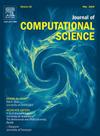PINN-parafoil:一种用于复杂伞翼动力学模拟的物理信息神经网络方法
IF 3.7
3区 计算机科学
Q2 COMPUTER SCIENCE, INTERDISCIPLINARY APPLICATIONS
引用次数: 0
摘要
精确求解复杂的伞翼动力学是模拟伞翼系统行为的关键。然而,由于这些模型的高度复杂性,传统的数值积分方法在计算效率方面存在问题。本文介绍了一种基于物理信息的神经网络方法(PINN-Parafoil),该方法可以有效地估计复杂伞翼动力学问题的数值解。通过利用神经网络优越的函数逼近能力,PINN-Parafoil提供了接近封闭形式的解决方案,克服了与传统积分技术相关的计算挑战。与标准的神经网络方法不同,PINN-Parafoil结合了伞翼动力学的控制物理定律作为先验约束,确保模型输出与训练数据和潜在的物理原理一致。为了验证该方法,针对9自由度(DOF)伞翼模型的传统龙格-库塔求解器对pin - parafoil模型进行了训练和测试。实验结果表明,与传统方法相比,PINN-Parafoil的计算效率提高了25倍,同时保持了较高的精度,与真实值的数值差异可以忽略不计。得到的运动曲线与参考轨迹具有一致的动力学特性。此外,烧蚀研究强调了物理约束在提高模型精度和稳定性方面的关键作用。PINN-Parafoil提供了一个快速,准确,可靠的代理模拟复杂的伞动力学。它的效率和有效性使其成为各种应用的有前途的工具,包括翼伞系统设计,轨迹规划和寻的控制。该方法为这些领域的研究和实际应用提供了强大的技术支持,为进一步探索和完善物理信息神经网络方法奠定了基础。本文章由计算机程序翻译,如有差异,请以英文原文为准。
PINN-parafoil: A physics-informed neural network method for complex parafoil dynamics simulating
Accurately solving complex parafoil dynamics is essential for simulating para-foil system behavior. However, traditional numerical integration methods struggle with computational efficiency due to the high complexity of these models. This paper introduces a physics-informed neural network approach (PINN-Parafoil) that efficiently estimates numerical solutions for complex parafoil dynamics. By leveraging the superior function approximation capabilities of neural networks, PINN-Parafoil delivers near closed-form solutions, overcoming the computational challenges associated with conventional integration techniques. Unlike standard neural network methods, PINN-Parafoil incorporates the governing physical laws of parafoil dynamics as prior constraints, ensuring that the model outputs align with both training data and underlying physical principles. To validate this approach, the PINN-Parafoil model was trained and tested against the traditional Runge–Kutta solver for the 9-degree-of-freedom (DOF) parafoil model. Experimental results show that PINN-Parafoil achieves 25 times greater computational efficiency compared to traditional methods, while maintaining high accuracy with negligible numerical differences from true values. The resulting motion curves exhibit consistent dynamic characteristics with reference trajectories. Additionally, ablation studies highlight the critical role of physical constraints in enhancing model accuracy and stability. PINN-Parafoil offers a fast, accurate, and reliable proxy for simulating complex parafoil dynamics. Its efficiency and effectiveness make it a promising tool for various applications, including parafoil system design, trajectory planning, and homing control. This method provides robust technical support for both research and practical implementations in these fields, setting a foundation for further exploration and refinement of physics-informed neural network methodologies.
求助全文
通过发布文献求助,成功后即可免费获取论文全文。
去求助
来源期刊

Journal of Computational Science
COMPUTER SCIENCE, INTERDISCIPLINARY APPLICATIONS-COMPUTER SCIENCE, THEORY & METHODS
CiteScore
5.50
自引率
3.00%
发文量
227
审稿时长
41 days
期刊介绍:
Computational Science is a rapidly growing multi- and interdisciplinary field that uses advanced computing and data analysis to understand and solve complex problems. It has reached a level of predictive capability that now firmly complements the traditional pillars of experimentation and theory.
The recent advances in experimental techniques such as detectors, on-line sensor networks and high-resolution imaging techniques, have opened up new windows into physical and biological processes at many levels of detail. The resulting data explosion allows for detailed data driven modeling and simulation.
This new discipline in science combines computational thinking, modern computational methods, devices and collateral technologies to address problems far beyond the scope of traditional numerical methods.
Computational science typically unifies three distinct elements:
• Modeling, Algorithms and Simulations (e.g. numerical and non-numerical, discrete and continuous);
• Software developed to solve science (e.g., biological, physical, and social), engineering, medicine, and humanities problems;
• Computer and information science that develops and optimizes the advanced system hardware, software, networking, and data management components (e.g. problem solving environments).
 求助内容:
求助内容: 应助结果提醒方式:
应助结果提醒方式:


